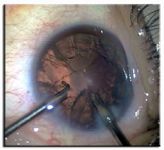Article
Ten tips reflect shift toward bimanual microincision phaco
The growing trend in bimanualmicroincision phacoemulsification has prompted many surgeons to evaluate this new surgical technique. Following are 10 tips for the beginning microincision surgeon. Some of these tips may also help the more experienced surgeon fine-tune his or her approach to bimanual microincision surgery.
The growing trend in bimanualmicroincision phacoemulsification has prompted many surgeons to evaluate this new surgical technique. Following are 10 tips for the beginning microincision surgeon. Some of these tips may also help the more experienced surgeon fine-tune his or her approach to bimanual microincision surgery.

2. Irrigating choppers come in essentially two varieties: side irrigating and forward irrigating. The forward irrigating choppers are preferable since infusion into the eye is guaranteed if the surgeon inadvertently pulls the chopper back during the procedure. The forward irrigation flow can also be used as a second surgical manipulator by irrigating lodged fragments out of the angle or dislodging epinuclear or cortical material from the capsular bag.
3. When inserting instruments into the eye, the irrigating chopper is inserted first, followed by the bare phacoemulsification needle.

4. Capsulorhexis formation is most easily achieved with a microincision capsulorhexis forceps but can be performed with a bent 27-gauge needle. If the needle tip is bent, care should be exercised when removing the needle from the eye since laceration of the roof of the incision can occur easily. A straight needle tip is preferable if the needle is used only for initiating the rhexis. The bottom line-invest in the forceps.
5. Higher IOPs can be achieved in the anterior chamber during cortical cleaving hydrodissection and hydrodelineation through bimanual microincisions. This is beneficial in that more efficient hydromaneuvers can be performed before eventual prolapse of viscoelastic through the incisions and normalization of the IOP. However, care should be taken in conditions with weakened zonules and thin posterior capsules to avoid complications. External pressure on the posterior lip of the microincision with the irrigating cannula during hydrodissection should avoid excessively high anterior chamber pressurization. Avoid cortical cleaving hydrodissection in posterior polar cataracts.

7. Bimanual microincision phacoemulsification can be performed with a chopping or divide-and-conquer technique. Chopping is preferable since it places less stress on the zonules and utilizes less ultrasound energy. My personal preference is to perform horizontal chopping on1-2+ NS and vertical chopping on 3-4+ NS cataracts. Each surgeon will develop his or her own preferences. Soft lenses are best approached with a "shuck-and-suck" technique (think oysters). Hydrodissect the clear lens out of the capsular bag and aspirate it with the bimanual I/A handpieces. No irrigating chopper needed.
Newsletter
Don’t miss out—get Ophthalmology Times updates on the latest clinical advancements and expert interviews, straight to your inbox.




